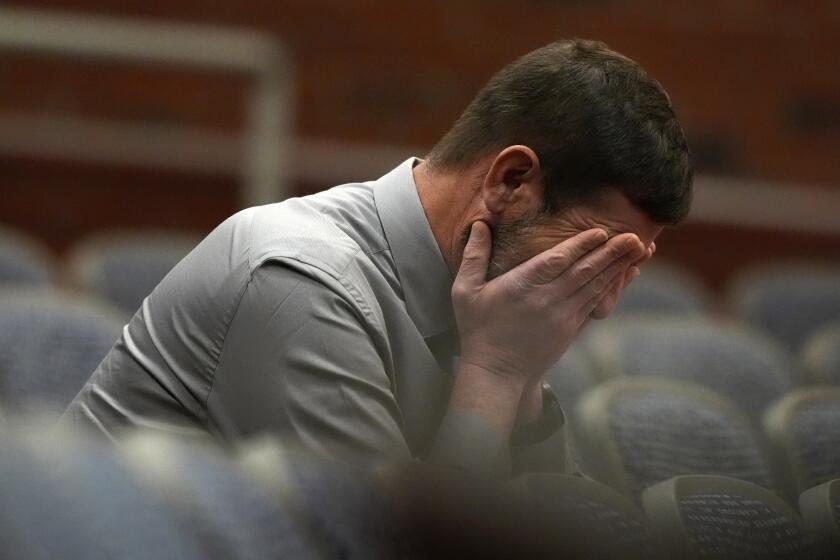Oil lingers in flooded Kansas town
Karla Mongan has gone door to door in Mississippi towns destroyed by Hurricane Katrina, handed out aid and comforted relatives of people who died during raging prairie wildfires.
But nothing prepared the Red Cross volunteer for her latest assignment -- operating a shelter for residents of her hometown. Coffeyville was swamped by oil-slicked floodwaters this week.
“It hits home when you can relate to everything that’s going on,” said Mongan, 40. “It’s very devastating.”
This entire blue-collar town of 11,000 still seemed stunned Friday, a full seven days after the Verdigris River spilled over its levees and washed through the eastern side of town. The floodwaters drenched the local oil refinery, spilling more than 40,000 gallons of oil and draping entire neighborhoods in a toxic shroud.
For a moment last week, environmental officials watched as the oil spill streamed south into Oklahoma, toward a reservoir that supplies Tulsa’s drinking water. The oil ultimately dispersed, but Coffeyville was not spared.
Local officials estimate that a quarter of the town was lost to flood damage. That’s more than 2,000 people homeless, and hundreds of houses and 60 businesses destroyed. Rescuers found a body in a motel room Thursday night and were still searching to see if there were other casualties. Tempers are rising -- a public meeting Thursday afternoon ended with police dragging off one angry woman in handcuffs.
“None of us was prepared for it,” said Mayor Virgil Horn, whose house was among those destroyed. “We only had enough time to get out. We lost everything.”
Since late May, torrential rains have drenched Texas, Oklahoma and Kansas. Floods have killed 13 people and destroyed an estimated 5,000 homes, and the federal government has declared 20 Kansas counties a disaster area. On Friday, skies over Kansas were sunny, but the downpour continued in Texas, where about 48,000 square miles was pounded by storms and, for the first time in 50 years, all the state’s rivers are in flood stage.
In Coffeyville, the deluge created an environmental disaster.
It’s not like a normal flood that, when waters recede, can be cleaned up with a mop and bleach, said City Clerk Cindy Price.
The refinery remains underwater, and spokesman Steve Eames said Friday that the owner, Coffeyville Resources, was still investigating how and why a storage tank there overflowed, releasing the oil into the floodwaters.
The lawns in the flood zone are black and the sour smell of oil hangs over town. The city sealed off the zone Friday morning after announcing that several rescue workers had become sick. The Environmental Protection Agency was conducting tests Friday.
Melvin Mark went to check his house Tuesday afternoon. The waters had only brushed the bottom of the structure, but that was enough.
“I walked in the door and the smell gave me a headache so bad I had to walk out,” Mark said.
An industrial town of brick warehouses and white clapboard houses, Coffeyville was founded in the 1870s as an Indian trading post before becoming an important stop on the railroad. Its major employers include an Amazon.com distribution facility and a John Deere factory.
Key to its success has been its control of the Verdigris River. Coffeyville has known modest floods, but it never expected to be hit hard. The highest the river had ever risen in town before was 26 feet, and the levees were raised to that level decades ago. This week, it crested at 30.4 feet.
Many homeowners did not have flood insurance because their houses were not classified as being in a flood plain.
Among those without flood insurance is retired city radio operator Herb Sollman, 70. He fled his home Saturday night and didn’t learn its fate until Tuesday, when a friend called him from a motorboat during a search-and-rescue operation.
“All I see of your house,” the man told Sollman, “is your radio antenna.”
Sollman was unsure what to do next -- the advice on how to go about recovering his losses all seemed as confusing as his new status.
“You hear about these homeless people all the time,” Sollman said. “I guess I am [homeless] now.”
After cleaning up and assessing the damage, the city’s next priority is finding housing for its displaced residents, said Price. “So we don’t lose these people. Because they’re only going to bunk with Grandma so long.”
About 70 people are staying at the main Red Cross shelter inside a spacious Baptist church on the west side of town. Mongan and her husband, Mike, have virtually relocated there too -- the country house where they live is without power, and the house in town they rented out and a garage where they stored belongings were destroyed in the flood.
She has avoided going to the flood zone. She rattled off what the town had lost: one of its grocery stores, the fairgrounds, the children’s recreation center.
“I don’t know what I would feel like if I go over there and look,” she said.
Tom and Angel Page don’t plan to return. They moved to Coffeyville last month from Iowa, determined to make a fresh start. They rented a house that felt like their first home, because the owners were far away in Arizona. Tom, 38, was hired as a meat-cutter at the local supermarket.
That was the grocery store wiped out in the flood. The Pages ended up at the shelter with nothing. Angel, 22, a McDonald’s cashier, can’t work; her restaurant was shut down by the health department because the water might be contaminated.
“We don’t have nowhere to go,” Tom Page said, leaning back on a metal folding chair outside the shelter. “We’re living here.”
More to Read
Start your day right
Sign up for Essential California for news, features and recommendations from the L.A. Times and beyond in your inbox six days a week.
You may occasionally receive promotional content from the Los Angeles Times.






